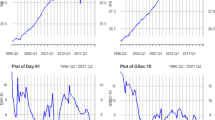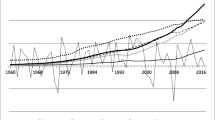Abstract
This paper examines the relevance of the Lucas critique for euro area money demand. Based on the money in the utility function approach, a vector error correction model is specified to investigate the relationship between money and inflation in times of policy shifts. A well defined equation for money demand is obtained. The results indicate that the evolution of M3 is still in line with money demand. In the long run, inflation is affected by asset prices and detrended output. Our results show that the Lucas critique can be refuted in case of euro area money demand for the period of quantitative easing. Thus, the estimated money demand equation provides reliable information for the conduct of future monetary policy.











Similar content being viewed by others
Notes
The DF-GLS test is more efficient than the standard ADF test in estimating the deterministic terms. See Elliott, Rothenberg and Stock (1996). The lag lengths for the unit root and cointegration tests is determined by the Akaike criterion. For unit root and cointegration testing see Kirchgässner, Wolters and Hassler (2013).
Interestingly Hendry and Doornik (1994) have found similar long run relationships in a system for UK M1.
The marginal model is estimated for the 2002Q1–2011Q4 sample, as house prices did not affect money demand in earlier periods.
References
Adalid R, Detken C (2007) Liquidity shocks and asset price boom/bust cycles. Working paper series no 732, ECB
Arnold IJM, Roelands S (2010) The demand for euros. J Macroecon 32:674–684
Artis M, Beyer A (2004) Issues in money demand: the case of Europe. J Common Mark Stud 42:717–736
Belke A (2000) Partisan political business cycles in the German labour market? Empirical tests in the light of the Lucas-critique. Public Choice 104:225–283
Benati L (2009) Long run evidence of money growth and inflation. Working paper series no 1027, ECB
Beyer A (2009) A stable model for euro area money demand. Revisiting the role of wealth. Working paper series no 1111, ECB
Beyer A, Juselius K (2010) Does it matter how aggregates are measured? The case of monetary transmission mechanisms in the euro area. Working paper series no 1149, ECB
Borio C (2007) Change and constancy in the financial system: implications for financial distress and policy. BIS working paper 237
Bosker EM (2006) On the aggregation of eurozone data. Econ Lett 90:260–265
Brand C, Cassola N (2004) A money demand system for euro area M3. Appl Econ 8:817–838
Carstensen K (2006) Stock market downswing and the stability of European Monetary Union money demand. J Bus Econ Stat 24:395–402
Clarida R, Galí J, Gertler M (2000) Monetary policy rules and macroeconomic stability. Q J Econ 115:147–180
Dreger C, Wolters J (2010a) Investigating M3 money demand in the euro area. J Int Money Financ 29:111–122
Dreger C, Wolters J (2010b) M3 money demand and excess liquidity in the euro area. Public Choice 144:459–472
Dreger C, Wolters J (2011a) Liquidity and asset prices. How strong are the linkages? Rev Econ Financ 1:43–52
Dreger C, Wolters J (2011b) Money and inflation in the euro area during the financial crisis. DIW discussion paper 1131
Dreger C, Wolters J (2014) Money demand and the role of monetary indicators in forecasting euro area inflation. Int J Forecast 30:303–312
Duca J, VanHoose D (2004) Recent developments in understanding the demand for money. J Econ Bus 56:247–272
Elliott G, Rothenberg T, Stock JH (1996) Efficient tests for an autoregressive unit root. Econometrica 64:813–836
Ericsson NR (1992) Parameter constancy, mean square forecast errors, and measuring forecast performance: an exposition, extension and illustration. J Policy Model 14:465–495
Ericsson NR, Irons J (1995) The Lucas critique in practice. Theory without measurement, Board of Governors of the Federal Reserve System. International finance discussion papers 506
Estrella A, Fuhrer JC (2003) Monetary policy shifts and the stability of monetary policy models. Rev Econ Stat 85:94–104
Favero C, Hendry DF (1992) Testing the Lucas critique. Rev Econom Rev 11:265–306
Fischer AM, Peytrignet M (1991) The Lucas critique in light of Swiss monetary policy. Oxf Bull Econ Stat 53:481–493
Fischer B, Lenza M, Pill H (2008) Money and monetary policy. The ECB experience 1999–2006. In: Beyer A, Reichlin L (eds) The role of money: money and monetary policy in the 21st century. European Central Bank, Frankfurt, pp 102–175
Goldfeld SM, Sichel DE (1990) The demand for money. In: Friedman B, Hahn F (eds) Handbook of Monetary Economics 1. Elsevier, Amsterdam, pp 299–356
Greiber C, Lemke W (2005) Money demand and macroeconomic uncertainty. Deut-sche Bundesbank discussion paper 26/05
Greiber C, Setzer R (2007) Money and housing: evidence for the euro area and the US. Deutsche Bundesbank, research center, discussion paper series 1. Economic studies 2007–2012
Hall SG, Swamy PA, Tavlas GS (2012) Milton Friedman, the demand for money and the ECBs monetary policy strategy. Fed Reserv Bank St Louis 94:153–186
Hansen H, Johansen S (1999) Some tests for parameter constancy in cointegrated VAR-models. Econom J 2:306–333
Hendry DF, Doornik JA (1994) Modelling linear dynamic econometric systems. Scott J Polit Econ 41:1–33
Hwang H-S (1985) Test of the adjustment process and linear homogeneity in a stock adjustment model of money demand. Rev Econ Stat 67:689–692
Johansen S (1995) Likelihood based inference in cointegrated vector autoregressive models. Oxford University Press, Oxford
Johansen S (2000) A Bartlett correction factor for tests on the cointegrating relations. Econom Theory 16:740–778
Juselius K (1998) Changing monetary transmission mechanisms within the EU. Empir Econ 23, 455–481. Reprinted in Lütkepohl H, Wolters J (eds) Money demand in Europe. Physica 1999, 189–215
Juselius K (2006) The cointegrated VAR model: methodology and applications. Oxford University Press, Oxford
Kirchgässner G, Wolters J, Hassler U (2013) Introduction to modern time series analysis, 2nd edn. Springer, Berlin
Kontolemis ZG (2002) Money demand in the euro area: where do we stand? IMF working paper WP 02/185
Leeper EM, Zha T (2003) Modest policy interventions. J Monet Econ 50:1673–1700
Lucas RE (1976) Econometric policy evaluation: a critique. Carnegie-Rochester Conf Ser Public Policy 1:19–46
Reis R (2013) Exit strategies and the Federal Reserve. In: Reinhart VR (ed) No way out: persistent government interventions in the great contraction. AEI Press, Washington, pp 98–116
Rudebusch GD (2005) Assessing the Lucas critique in monetary policy models. J Money Credit Bank 37:245–272
Smets FR, Wouters R (2007) Shocks and frictions in US business cycles: a Bayesian DSGE approach. Am Econ Rev 97:586–606
Walsh CE (2010) Monetary theory and policy. MIT Press, Cambridge
Woodford M (2008) How important is money in the conduct of monetary policy? J Money Credit Bank 40:1561–1598
Acknowledgments
The authors would like to thank two anonymous referees for their comments and suggestions. They have substantially improved the paper.
Author information
Authors and Affiliations
Corresponding author
Additional information
This paper is an extended and updated version of Dreger and Wolters (2011b): Money and inflation in the euro area during the financial crisis, DIW Discussion Paper 1131.
Rights and permissions
About this article
Cite this article
Dreger, C., Wolters, J. On the empirical relevance of the Lucas critique: the case of euro area money demand. Empirica 43, 61–82 (2016). https://doi.org/10.1007/s10663-015-9289-z
Published:
Issue Date:
DOI: https://doi.org/10.1007/s10663-015-9289-z




